To this very day, the Dutch use the expression “Jan Steen household” to describe an untidy, rowdy home. Jan Steen (1626-1679) is a household name in The Netherlands. This Catholic artist, born into a well-to-do brewer family, is one of the most popular Dutch 17th-century artists. Four hundred of his paintings have survived. He painted punctilious portraits, religious works, historical paintings, and genre pieces, as well as his celebrated peasant and household scenes. A characteristic of all his work is his chucklesome wit, often accompanied by an underlying moral innuendo. Steen, shown below as a lute player, was known to portray himself in diverse roles. He regularly figured in his own paintings, often as a barkeeper, an intoxicated man, or some outlandish character in the background. In Twelfth Night Feast, he is the rollicking man standing behind the woman pressing her hands on her ears. Steen never shunned self-mockery.

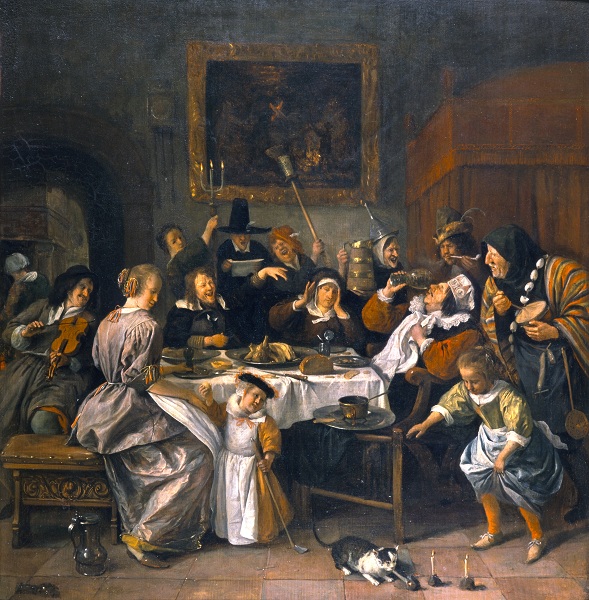
Left: Self-Portrait playing a lute – c. 1663-65 – oil on panel – 55.3 x 43.8 cm – Museo Nacional Thyssen-Bornemisza, Madrid
Right: Twelfth Night Feast – c. 1671 – 58.4 x 55.9 cm – Woburn Abbey, Bedfordshire, United Kingdom (slightly cropped)
Jan Steen painted celebrations. Whether painting a village feast, a marriage, a religious holiday, or peasants making merry on a pleasant summer day, dancing revellers are bound to be present. In an early work, The May Dance Before an Inn, villagers enjoy dancing under a charming garland arrangement. The men and women, placed alternatively, move clockwise in a straightforward circle. They are accompanied by the fiddler, perched on the mound just behind the dancers. The fiddler may be difficult to spot, but the grimaces of the dancers are definitely distinguishable. Caricature is a widespread feature throughout Steen’s work. Check the peasant woman as she tilts her unappealing face upwards. And what are your thoughts about the man directly behind her with a hideous smirk on his face?
The peasant’s posture and rudimentary footwork suggest that the dance movements are limited to walking, skipping, and basic forward-bound steps. In a less prominent scene, an elderly peasant woman and a young girl dance under the shadow of two large trees. This tender moment contrasts sharply with the enticing woman who is shown pulling up her stocking and the young male urinating in the gateway. It is also interesting to note that the structures with pointed rooftops are unusual for the Dutch artist. Steen appears to be inspired by traditional German architecture.
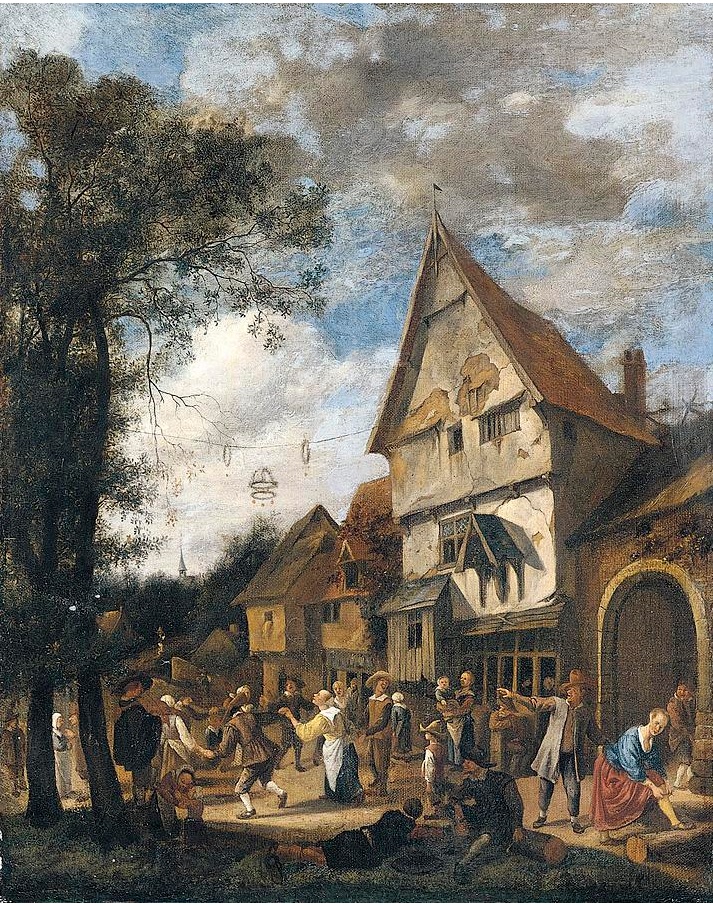
Another early work,‘Peasants Dancing at an Inn’, definitely has a Dutch setting: an inn, distant fields and farms, a church on the horizon, and a cloud-filled sky. Steen’s boorish figures drink, smoke, dance, caress, and enjoy themselves in front of the local tavern. A besotted peasant, completely oblivious to the merrymakers, sleeps on the ground. Steen draws the viewer’s attention to a group of boisterous provincials dancing in a circular formation. He has not only placed the whirling peasants in the centre of the canvas but has also given the women striking white headscarves; they form a strong contrast against the darker background. Notably, this is the only occasion where Steen uses a vivid white hue. A violinist, standing on a wooden barrel, towers over the dancing foursome. Unlike the easy-going May Dance, these peasants heave, incline, take broad, unruly steps, and pull each other practically off-balance. Each figure is a caricature. Paintings by the brilliant storyteller Jan Steen invariably suggest more than the narrative alone. The drinking, the merry-making, and the sniffing dog are all indicators of degeneracy. The ominous clouds may foreshadow damnation. The distant church offers redemption.
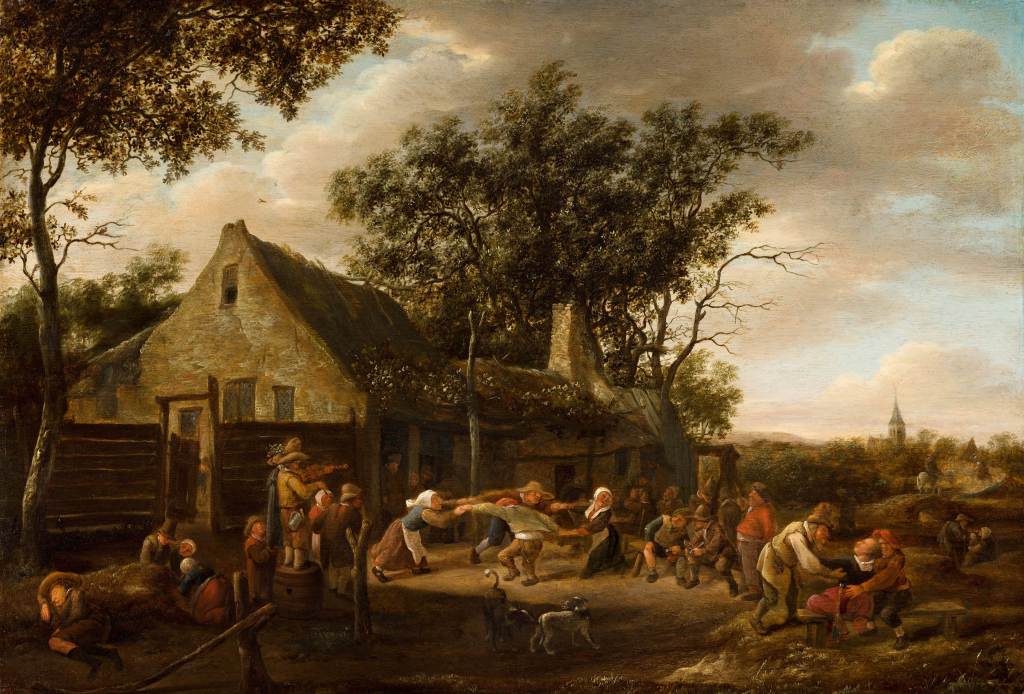
Don’t be misled. The following painting depicting a merry scene of peasants and townsfolk dancing, drinking, flirting, and enjoying themselves implies more than meets the eye. Scenes describing peasant life were highly popular in the 17th century, sought after by middle-class burghers and the elite alike. Peasant life represented ‘an alternative world‘. ‘Peasants Before an Inn’ and similar paintings reinforced the elevated lifestyle and the accompanying sense of superiority of privileged society. Moreover, the loutish activities and rough manners of the provincials proved an unlimited source of amusement.
Peasants before an Inn combines praise and warning. On the one hand, we have a near idyllic scene of country life. On the other hand, the figure of the drunken bumpkin, explicitly placed in the centre of the painting, symbolises the innate foolishness of peasant folk. Meanwhile, the well-dressed man, clearly a visitor from town, grins haughtily in silence. His country counterpart, a chubby peasant standing on the opposite side of the canvas, smiles cordially at the viewer, as does the friendly little boy holding a birdcage.
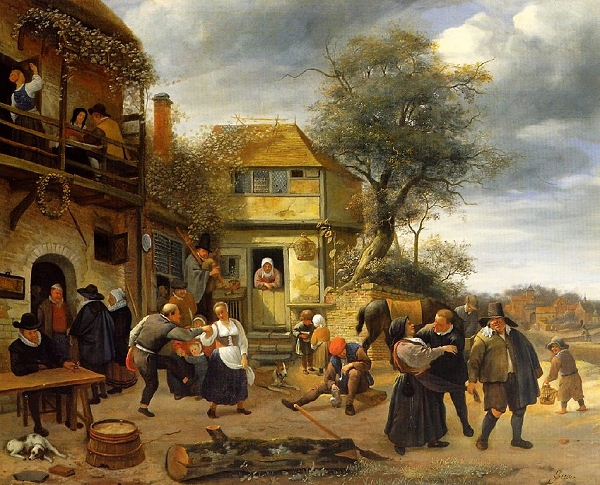
When painting a dance image, an artist inadvertently faces the challenge of creating movement in a two-dimensional medium. The task is less complex if a specific dance form, such as a tango or a waltz, has identifiable stylistic characteristics. But how do you depict peasant dances that lack distinct stylistic elements?
Steen follows in the footsteps of Bruegel the Elder, Adriaen van Ostade, Cornelis Dusart, and David Teniers. The male dancing figure, as painted by Steen and the other artists, is a crude, robust fellow who usually rests all of his weight on one leg and raises his free leg at a right angle. The elevated foot is often flexed. The torso is inclined forward or sideways to suggest physical activity. The illusion of mobility is enhanced by positioning the arms in an active alignment and lifting the supporting heel slightly off the ground. The result is an off-balanced body position that indicates that the dancer is transferring weight while moving rhythmically to the following movement.
This description illustrates not only the male dancing figure in Peasants Before an Inn but also the dancing figures from the circle dances, as depicted above. In each of the preceding and succeeding examples, the figure balances on one leg, with the body tilted or inclined. The countrywoman occasionally adopts a similar manner, but she is equally likely to stand casually upright. She captures the illusion of motion through turns, twists, and movements of the upper body and head. Furthermore, the peasant woman’s feet and ankles are clearly visible. This allows the artist to suggest movement based on the position and direction of her feet and legs.
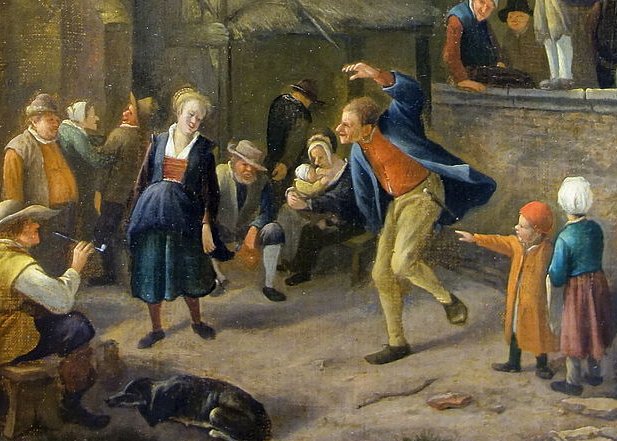
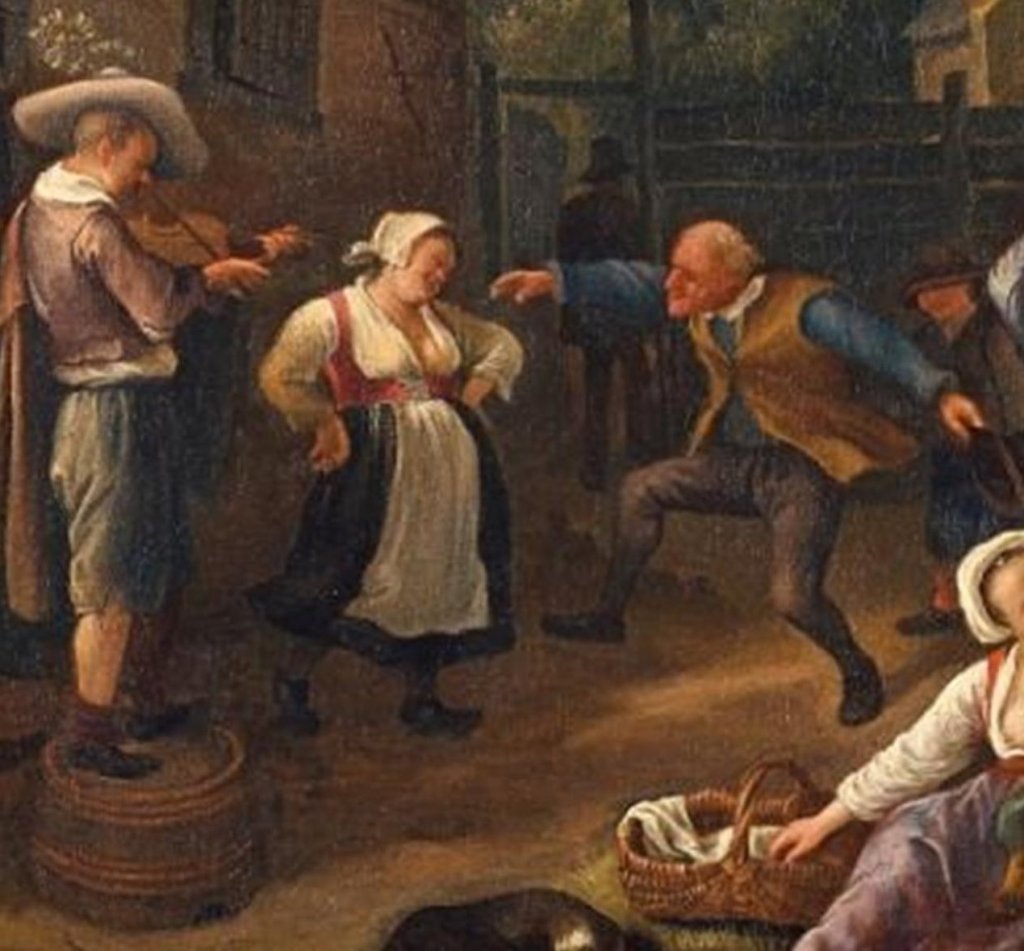

The Violin Player / Le Ménétrier – c. 1670 – oil on canvas – 43.5 cm x 49.2 cm – Palais des beaux-arts de Lille (cropped)
Peasants Making Merry in front of a Tavern – date unknown – oil on canvas – 62.5 cm x 77 cm – Kunsthaus Lempertz, Cologne / Private Collection (cropped)
Merry Company in an Inn/ The Country Wedding – 1662-1664 – oil on canvas – 105.4 cm x 149.9 cm – Private Collection (cropped)
Jan Steen painted over thirty works of peasants making merry at an inn. He often included dancing couples and circle dances. A late work, Merry Making Outside an Inn (formally named Fair at Warmond), depicts a sweeping view of a country fair where peasants and townspeople interact. All the figures, despite being part of a crowd, are distinct individuals. Jan Steen fills the canvas with vignettes, each personality telling their own tale. In the lower left corner, the mother nursing her infant is unaware that her son is about to snatch cherries from a bag. Blatantly obvious to all is the elderly woman relieving herself near the stream. A little farther back, an elegantly dressed man, standing behind an old man leaning on a stick, forces his attention on a young girl. What, you may ask, is going on? Those sniffing dogs, reminiscent of the two dogs illustrated in Peasant Dancing at an Inn, are undoubtedly a sign of looming impropriety.
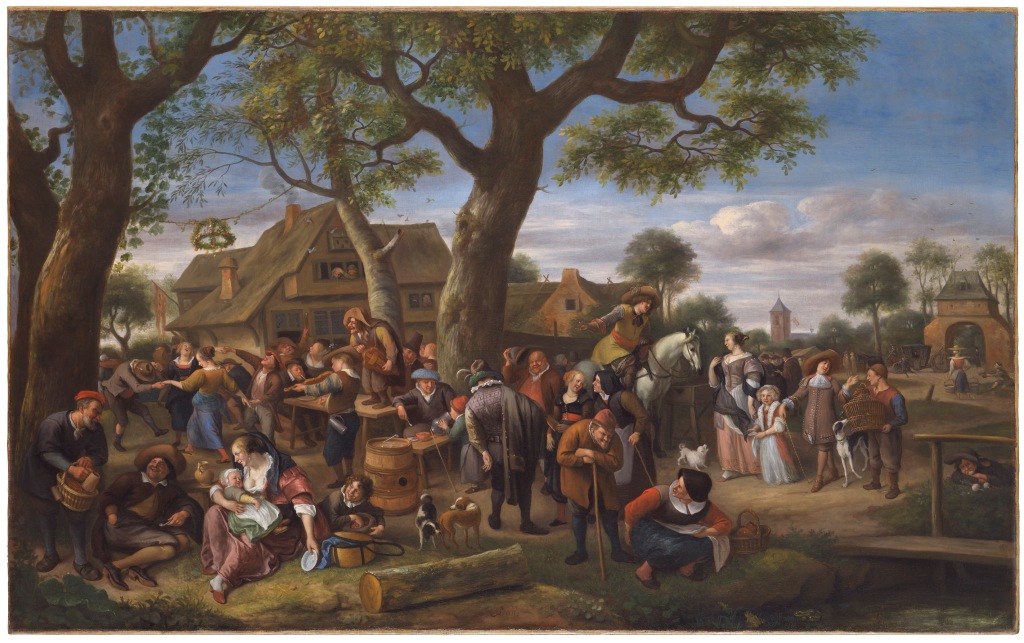
Steen and his peers often included townsfolk in their paintings of peasant festivities. Townsfolk regularly visited a fair to enjoy a country outing or to observe peasant life. You will have noticed that the wealthy woman is speaking with a well-to-do man on horseback. Their conversation is apparently amusing if the mounted gentleman’s gesture towards the group of peasants is any indication. Merry Making Outside an Inn is brimful of stories. This fascinating composition abounds in riveting characters and caricatures. Steen, masterful in portraying human nature, juxtaposes the wealthy and poor, young and old, the brazen and the dignified, the proper and unrefined, and considerably more in the most engaging fashion, but always with an underlying sense of morality.
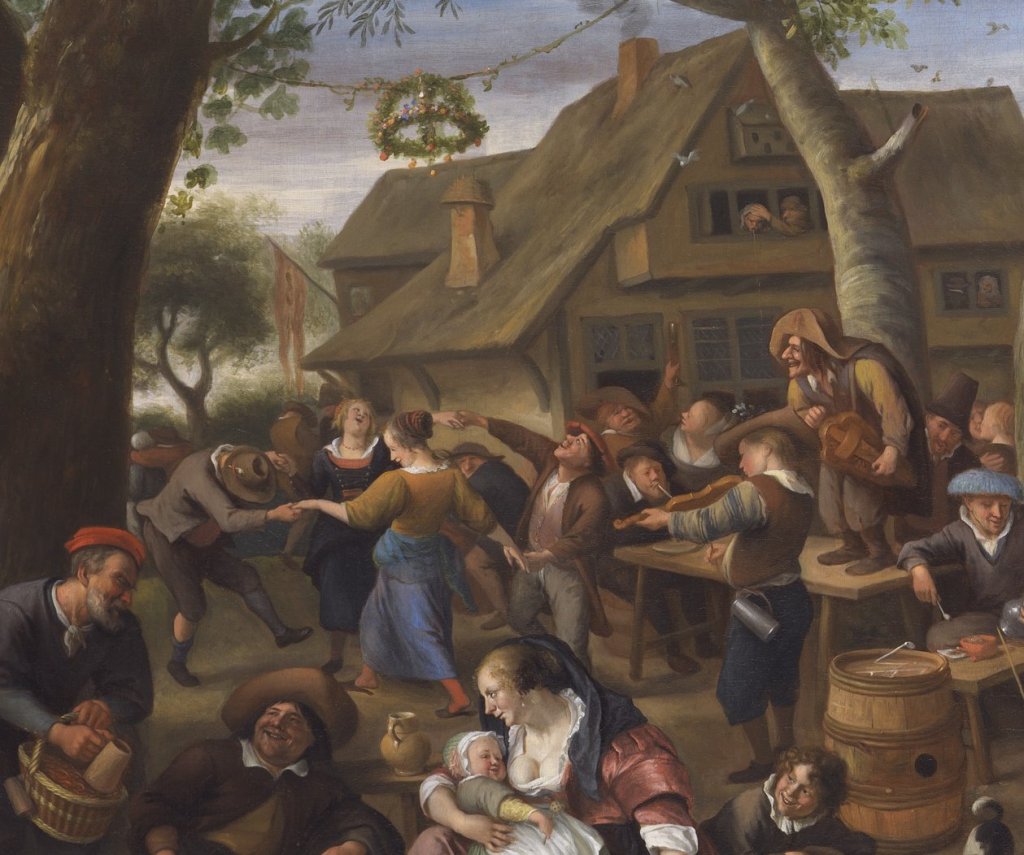
To return to the dancers. Two couples have formed a circle beneath a floral crown suspended on a rope between the two trees. Their rollicking dance is flanked by a smoking man, two lovers, a boisterous couple, and a tall tree. The rustic on the left dances with unequalled abandon. He somehow manages to hold his partner’s hands despite his unrestrained leg kicks and drooping torso. The four dancers gather remarkable momentum. Steen visualises speed through the strong spiral rotation and pronounced hip projection of the peasant woman wearing a blue skirt. This, along with her long strides, results in a powerful forward thrust.
The dancers are accompanied by a young boy playing the violin and a crooked old man playing the hurgy-gurdy. Steen places the eccentric musician high on a table. His striking personality, accentuated by his turned-up hat, ragged face, pointed chin, and disorderly hair, is characteristic of Steen’s tremendous sense of humour. It is intriguing that Steen has placed the quirky musician and the mounted gentleman on the same visual level. Humour, irony, or empathy?